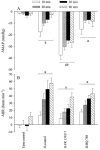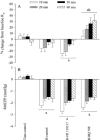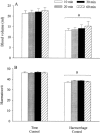Role of endothelin ET(A)- and ET(B)-receptors in haemodynamic compensation following haemorrhage in anaesthetized rats
- PMID: 11861314
- PMCID: PMC1573196
- DOI: 10.1038/sj.bjp.0704530
Role of endothelin ET(A)- and ET(B)-receptors in haemodynamic compensation following haemorrhage in anaesthetized rats
Abstract
1. This study examined the role of endothelin ET(A) and ET(B) receptors on haemodynamic compensation following haemorrhage (-17.5 ml kg(-1)) in thiobutabarbitone-anaesthetized rats. Rats were divided into four groups (n=6 each): time-control, haemorrhage-control, haemorrhage after treatment with FR 139317 (ET(A)-receptor antagonist), and haemorrhage after treatment with BQ-788 (ET(B)-receptor antagonist). 2. In the time-control rats, there were no significant changes in any haemodynamics for the duration of the experiments. Relative to the time-control rats, rats given haemorrhage had reduced mean arterial pressure (MAP), cardiac output (CO) and mean circulatory filling pressure (MCFP), but increased systemic vascular resistance (R(SV)). Venous resistance (R(V)) was slightly (but insignificantly) reduced by haemorrhage. MAP, however, gradually returned towards baseline (-17+/-4 and -3+/-2 mmHg at 10 and 60 min after haemorrhage, respectively) as a result of a further increase in R(SV). 3. Pre-treatment with FR 139317 (i.v. 1 mg kg(-1), followed by 1 mg kg(-1) h(-1)) accentuated haemorrhage-induced hypotension through abolition of the increase in R(SV). FR 139317 did not modify haemorrhage-induced changes in CO, MCFP and R(V). 4. Pre-treatment of BQ-788 (3 mg kg(-1)) did not affect MAP or MCFP following haemorrhage; however, CO was lower, and R(SV) as well as R(V) were higher relative to the readings in the haemorrhaged-control rats. 5. These results show that following compensated haemorrhage, ET maintains arterial resistance and blood pressure via the activation of ET(A) but not ET(B) receptors.
Figures




References
-
- CHANG H., WU G.-J., WANG S.-M., HUNG C.-R. Plasma endothelin level changes during hemorrhagic shock. J. Trauma. 1993;35:825–833. - PubMed
-
- CHIEN S. Role of sympathetic nervous system in hemorrhage. Physiol. Rev. 1967;47:215–288. - PubMed
-
- DARLINGTON D.N., SHINSAKO J., DALLMAN M.F. Responses of ACTH, epinephrine, norepinephrine, and cardiovascular system to hemorrhage. Am. J. Physiol. 1986;251:H612–H618. - PubMed
-
- DREES J.A., ROTHE C.F. Reflex venoconstriction and capacity vessel pressure-volume relationships in dogs. Circ. Res. 1974;34:360–373. - PubMed
Publication types
MeSH terms
Substances
LinkOut - more resources
Full Text Sources
Medical

